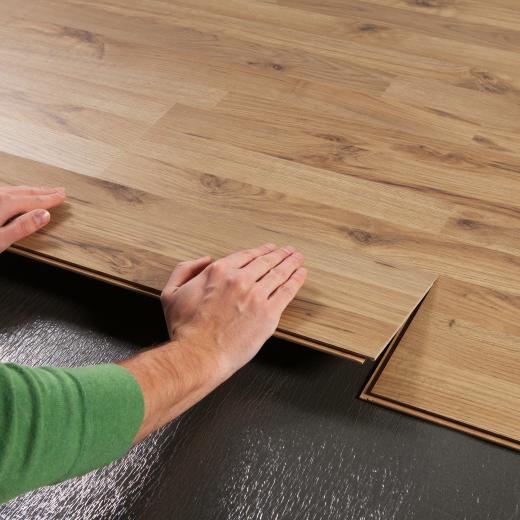(Consumer press) Laminate flooring needs the right underlay Laying using a system – but how?
27 May 2014
Laminate flooring is usually laid floating. Underlay materials and subflooring are therefore important elements of the flooring system – and often provide sufficient grounds for complaint if the flooring is laid incorrectly. This can be avoided: with the right underlay, you can optimise the entire laminate flooring system and thus extend its service life.
Even high-quality laminate flooring can only fully demonstrate its advantages if the laying basis works well as part of the whole system. The underlay represents the interface between the laminate flooring and the subflooring. As a result, it must assume various functions, compensating for any unevenness in the underflooring and relieving load on the click system of the boards. It protects the laminate flooring against daily wear from foot traffic and in the case of impacts from falling objects etc., as well as from long-term strain caused by heavy furniture. In addition, it serves as an effective barrier against increasing residual building moisture. Lastly, the right underlay can also optimise the qualities of the laminate flooring as concerns soundproofing and heat insulation.
New data sheet: concrete guidelines and recommendations
If the underlay is already integrated into the laminate board during manufacture, i.e. "laminated", there are no problems – but it is a different matter for loosely laid underlay. Until present, there was no regulation that specified binding requirements concerning loosely laid laminate underlay. It was not until last year that a first technical specification (CEN/TS 16354) was introduced on the European level, considered as a precursor to a future European product standard. Yet how can we start to put these requirements into practice in order to optimise our flooring? A new technical data sheet from the EPLF – European Producers of Laminate Flooring – on the topic of underlay materials may come in useful; it not only describes the testing methods from the new CEN/TS 16354, but also explains what the technical abbreviations stand for. Moreover, it specifies concrete guidelines and recommendations for the reference values that loosely laid laminate underlay should fulfil. It aims to make the laminate flooring system – the combination of flooring and underlay – even better, safer and more comfortable.
For example, an underlay material that is too soft can cause problems for the entire flooring system. Generally, sufficient mechanical stability and a corresponding compressive strength value should therefore be ensured. In practice, this means that the larger the compressive strength value, the better the underlay can protect the connection system and counteract breakage of the board joints. In the EPLF data sheet, the compressive strength reference value for loose underlay is specified as 10 kPa (kilopascals) minimum, while for increased requirements, the compressive strength value is specified as 60 kPa minimum. The data sheet containing all recommendations is available to interested consumers as a free PDF download from the EPLF association website (www.eplf.com).
Image captions
elnd1408_b1: Laminate flooring is usually laid floating. The right underlay optimises the overall floor structure and thus extends the product's lifetime. – Photo: HARO
elnd1408_b2: The underlay represents the interface between the laminate boards and the subflooring. As a result, it must assume important functions in order to protect the entire flooring system. – Photo: Selit Dämmtechnik GmbH
elnd1408_b3: All components of the flooring system must be suited to one another so that the laminate flooring can look good for longer, even with daily wear. – Photo: Kaindl
elnd1408_b4: Helpful information for laminate flooring users: The free EPLF data sheet "Underlay materials under laminate flooring elements – test standards and key data" can be found at www.eplf.com. – Photo: EPLF
Contact for press enquiries
Anne-Claude Martin
Press Officer
press(at)eplf.com
Rue Defacqz 52
B - 1050 Ixelles
Phone +32 2 788 31 68
